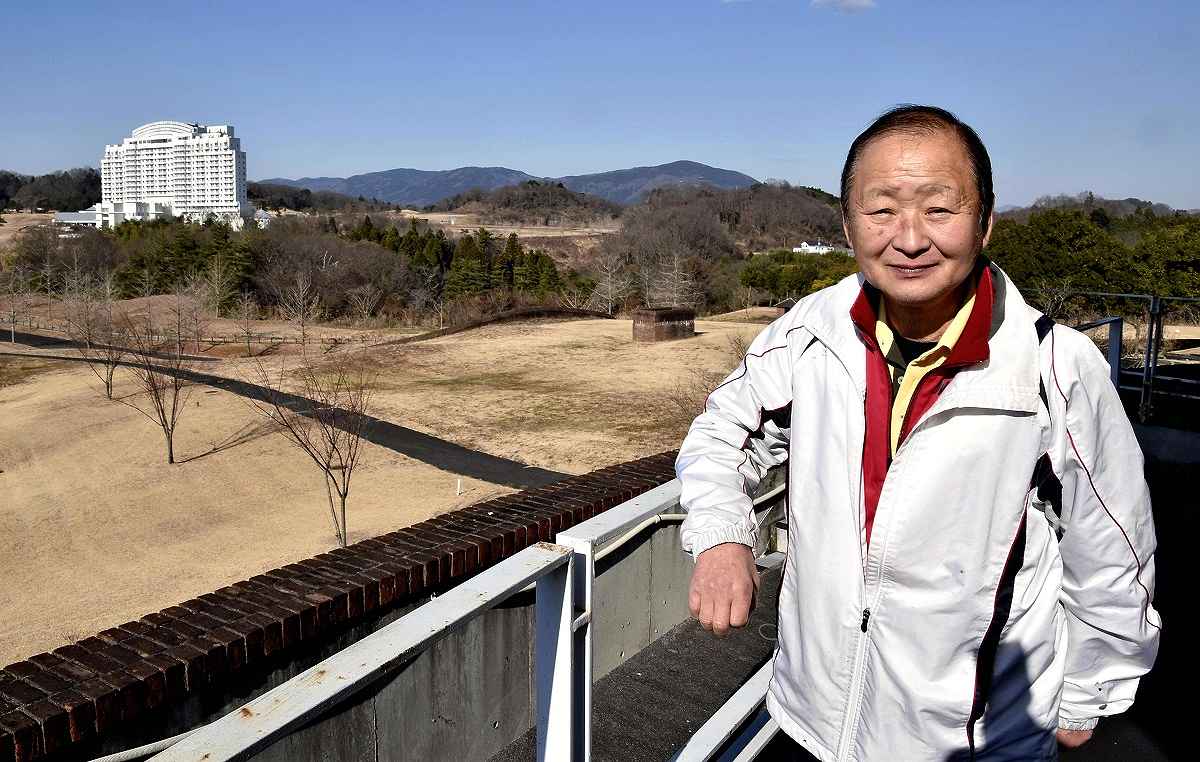
Residents of Okuma, Fukushima Prefecture, wait for buses in front of town hall after the entire town was ordered to evacuate on March 12, 2011.
The Yomiuri Shimbun
12:28 JST, January 17, 2021
In the aftermath of the 2011 Great East Japan Earthquake, many communities chose to start over by picking up and moving as a group to higher ground. It was part of a project to have residents evacuate to safer locations while maintaining the bonds of community.
This concept was similar to the “temporary town” scheme for evacuees of the Tokyo Electric Power Company Holdings Inc.’s nuclear accident, in which fleeing residents gathered in the same place in an attempt to regain some semblance of their former lives.
It is only natural to want to preserve one’s hometown, particularly when one plainly sees how fragile a community can be.
The damage from the accident at TEPCO’s Fukushima No. 1 nuclear plant was spread over an unprecedentedly wide area. The evacuation-designated zone in Fukushima Prefecture alone covered 1,150 square kilometers at one point. That was double the area flooded by the 2011 quake-triggered tsunami, and 1.8 times the combined size of Tokyo’s 23 wards. In some towns, evacuation orders were issued to cover the entire town.
Such a “town-wide evacuation” aroused a sense of crisis among residents that a prolonged evacuation could cause their hometown to disappear forever. From such a mental state, a plan was put into motion — building a “temporary town” out of an existing golf course.
The proposed site was the Helena International Country Club in the suburbs of Iwaki, Fukushima Prefecture, more than 50 kilometers south of the nuclear power plant. Many people from the towns of Okuma and Futaba, where the nuclear power plant is located, evacuated to Iwaki.
Residents of the three municipalities formed a coalition in 2012 called the Iwaki-Futaba Kizuna-no-kai, which pushed forward the plan.
The 270-hectare site, which includes an 18-hole golf course and a horseback riding club, tick all of the boxes for developing a residential area — the JR Joban Line runs in front of the main gate; the facility was sold to the current management company when the bubble economy burst; a 15-story building, which was to house a resort hotel, is on the verge of completion; and it has electric and water supply lines.
According to the plan, 3,000 single-family homes and a school would be built, and the unfinished building would house a town hall, medical clinic and condominiums. A new station was to be opened in front of the main gate, and a road built connecting to a nearby expressway.
Major general contractor Taisei Corp., responding to a request from the Kizuna-no-kai, drew up a comprehensive blueprint at the end of 2012 that included such details as the floor space of everything from a library to a post office to a day-care center.
But soon after, the temporary town project fizzled out. In addition to facing opposition from Iwaki city, governments looking at the estimated ¥36 billion price tag were reluctant to get on board.
Some people dismissed the plan as being unfeasible from the start. And there were other factors at play.
■ Broken dreams
For Morio Yaguchi, the idea of creating a “temporary town” on a golf course provided him for the first ray of hope following the nuclear accident.
Yaguchi evacuated to Iwaki from the town of Futaba, where, in his pre-accident life, he ran an osteopathic clinic. In March 2012, a year after the disaster, he reopened his clinic in central Iwaki, where many Futaba residents had relocated. “I want to create a gathering place for Futaba people,” he thought at the time. It was then that Yaguchi got word of the temporary town project.
“Residents who have separated can come to live together again,” recalled Yaguchi, 66.
Yaguchi was deeply involved from the beginning in the formation of the Kizuna-no-kai, and sought cooperation by handing out copies of the implementation plan to townspeople that he knew. Copies were snapped up and the news of the project spread by word of mouth.
On Aug. 25, 2012, the Kizuna-no-kai held a general meeting in Iwaki that draw about 300 people, mainly evacuees from Okuma and Futaba. Diet members elected from the area also attended. Yaguchi took the stage to make his case, stating, “What we want is for the people of Futaba county to come together in one place and create a safe place where they can live together with their families.”
The following spring, about 80 people loaded onto two buses and headed to Tokyo and the headquarters of the Liberal Democratic Party, which had just regained political power. Bearing a petition containing about 7,000 signatures, they appealed to then Secretary General Shigeru Ishiba and other party leaders for their help in realizing the plan. On the bus ride home, every face had a smile in the belief that the plan was a done deal.
The Helena International Country Club was also cooperative, showing around evacuees whenever they came to look at the site. “We have a strong desire to support those who are unable to return to their hometowns,” said Helena’s managing director Daigo Takahashi, 36, upon hearing their plight.
■ Turmoil in city planning
But Iwaki, the city which took in the evacuees, took a cautious stance.
All entities — municipalities, prefectures and the national government — were each proceeding with their own studies into temporary town projects. Each was different in its own right, and in addition to Okuma, the towns of Namie and Tomioka brought up Iwaki as a candidate site for their new communities.
In August 2012, Iwaki held a hearing with the eight towns and villages making up Futaba county. Then Iwaki Mayor Takao Watanabe, 75, suggested that instead of having the evacuees concentrated in one place, they be dispersed in housing to be built throughout the city.
Iwaki has a similar climate to the coastal towns where the nuclear power plant is located, and about 24,000 people, or 15% of the total evacuees, flowed into the city.
This caused problems where the temporary housing was concentrated in terms of straining medical facilities, supermarkets and distribution routes. Real estate prices skyrocketed due to sudden demand.
Traffic congestion on main roads became chronic, particularly during the morning and evening rush hours. Private cars of evacuees returning temporarily to their homes, added to the trucks and other vehicles involved in decommissioning, restoring and decontaminating the nuclear plant, caused long traffic jams. The situation led to turmoil in Iwaki’s own urban planning.
“There was a risk that the site of the temporary town would be abandoned once the evacuees returned to their homes sometime in the future,” a former senior city official said. “It was difficult to make changes to existing urban planning for the sake of such a project.”
When current Futaba Mayor Shiro Izawa, 62, was first elected in March 2013, he shifted the direction of the dispersal from solely Iwaki to other cities such as Koriyama.
Yaguchi, who entrusted his dream to the Kizuna-no-kai, continues to operate his osteopathic clinic in Iwaki with his wife, his son and his son’s wife. But the opportunities to treat evacuees from Futaba have become few and far between as the population aged over the past 10 years
“If the temporary town had come about, we wouldn’t have remained separated,” Yaguchi said. “Why didn’t it happen? I still see it in my dreams.”

Morio Yaguchi, a Futaba resident active in the coalition seeking to realize the “temporary town”
Popular Articles
Popular articles in the past 24 hours
-

AI Personalizes Foreign Language Lessons in Pilot Projects, Inspi...
-

Bank of Japan Considered U.S. Tariffs, Coming Shunto Wage Hike Ta...
-

Green Expo 2027 Gains Attention from Osaka Expo Fans; Event Plann...
-

Japan's 1st Domestically Manufactured EV Police Motorcycle Unveil...
-

Kumamoto: Trams to Continue Accepting IC Cards after Strong Oppos...
-

Yen Weakens against Peers after BOJ Raises Interest Rates
-

Colorful New Year Lucky Charm Production Reaches Peak in Shizuoka...
-

Coffee Omakase Is Japan's Love Letter to Caffeine
Popular articles in the past week
-

University of Tokyo Professor Discusses Japanese Economic Securit...
-

Tsukiji Market Urges Tourists to Avoid Visiting in Year-End
-

Israeli Tourists Refused Accommodation at Hotel in Japan’s Nagano...
-

China to Impose Sanctions on Shigeru Iwasaki, Former Head of Japa...
-

Japan to Support Central Asian Logistics Route That Bypasses Russ...
-

U.S. Senate Resolution Backs Japan, Condemns China's Pressure
-

Speed Skater Yukino Yoshida Clinches Ticket to Milan
-

Kenta Maeda Joins Rakuten Eagles; Returns from American MLB to Ja...
Popular articles in the past month
-

Keidanren Chairman Yoshinobu Tsutsui Visits Kashiwazaki-Kariwa Nu...
-

Imports of Rare Earths from China Facing Delays, May Be Caused by...
-

Japan Exports Rise in October as Slump in U.S. Sales Eases
-

University of Tokyo Professor Discusses Japanese Economic Securit...
-

Japan Pulls out of Vietnam Nuclear Project, Complicating Hanoi's ...
-

Govt Aims to Expand NISA Program Lineup, Abolish Age Restriction
-

Blanket Eel Trade Restrictions Rejected
-

Key Japan Labor Group to Seek Pay Scale Hike
"Society" POPULAR ARTICLE
-

M4.9 Earthquake Hits Tokyo, Neighboring Prefectures
-

M7.5 Earthquake Hits Northern Japan; Tsunami Waves Observed in Hokkaido, Aomori and Iwate Prefectures
-

Tsukiji Market Urges Tourists to Avoid Visiting in Year-End
-

Israeli Tourists Refused Accommodation at Hotel in Japan’s Nagano Pref., Prompting Protest by Israeli Embassy and Probe by Prefecture
-

M5.7 Earthquake Hits Japan’s Kumamoto Pref., Measuring Upper 5 Intensity, No Tsunami Expected
JN ACCESS RANKING
-

Keidanren Chairman Yoshinobu Tsutsui Visits Kashiwazaki-Kariwa Nuclear Power Plant; Inspects New Emergency Safety System
-

Imports of Rare Earths from China Facing Delays, May Be Caused by Deterioration of Japan-China Relations
-

University of Tokyo Professor Discusses Japanese Economic Security in Interview Ahead of Forum
-

Japan Pulls out of Vietnam Nuclear Project, Complicating Hanoi’s Power Plans
-

Govt Aims to Expand NISA Program Lineup, Abolish Age Restriction







